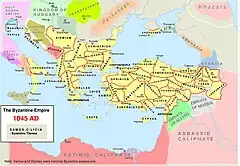Stephen I of Croatia
Stephen I (Croatian: Stjepan I.; c. 988 – 1058) was King of Croatia from c. 1030 until his death in 1058 and a member of the Trpimirović dynasty (Krešimirović branch). Stephen I was the first Croatian king whose given name was "Stephen" ("Stjepan"), as Držislav added the name Stephen at his coronation. His ban was Stephen Praska.
| Stephen I | |
|---|---|
| King of Croatia | |
| Reign | 1030–1058 |
| Predecessor | Krešimir III |
| Successor | Peter Krešimir IV |
| Born | c. 988 |
| Died | 1058 |
| Burial | Church of St. Stephen, Solin |
| Spouse | Hicela Orseolo |
| Dynasty | Trpimirović |
| Father | Svetoslav Suronja |
| Religion | Christianity |
Biography
Background
Stephen was the son of former King Svetoslav Suronja,[1] who gave him as a hostage to the Venetian doge, Pietro II Orseolo. He married the latter's daughter, Hicela Orseolo, who bore him two sons: Peter Krešimir IV, who succeeded him as the King of Croatia, and Gojslav, the father of the future Croatian King Stephen II.
Reign as king
Stephen formally succeeded his uncle Krešimir III in 1030, although it is likely that he co-ruled with him from 1028. The King continued his predecessors' ambitions of spreading rule over the coastal cities and expended much effort in that regard, but it was all eventually in vain.
In 1035, Croatia under Stephen involved itself in the affairs of the neighbouring Holy Roman Empire between the Carinthian count Adalbero and Holy Roman Emperor Conrad II. Aldabero was accused on 18 May 1035 during the Bamberg assembly of conspiring against the emperor with help from the Croats. Because of this, the Emperor strengthened the southeastern part of his state, where it bordered with Croatia.[2]
Between 1038 and 1041, Stephen managed to successfully conquer Zadar from the Venetians for a short period, possibly with the help of the newly crowned Hungarian king Peter Orseolo, his wife's nephew.[2] Stephen controlled the city until 1050, when it was reconquered by doge Domenico I Contarini.

In an effort to maintain Roman influence over the Dalmatian cities, the Byzantine emperor granted Stephen Praska, a ban serving under king Stephen I, the title of Protospatharios.
Later life and death
Stephen I established the diocese of Knin in 1040, which stretched to the north until it met the river Drava.[3] The bishop of Knin had also the nominal title of "Croatian bishop" (Latin: episcopus Chroatensis).
Trade and commerce flourished under Stephen I. A burgeoning aristocracy emerged in Zadar, Biograd, Knin, Split and other coastal cities.
It is traditionally considered that Stephen I ruled until 1058 when his son, Petar Krešimir IV, took over. However, according to historical sources, he ruled until the beginning of the 1060 and had good relationship with papal reforms and even gifting a parrot to Pope Leo IX.[4]
His successors referenced his burial place as the "fields of Elysium" (Elisio campo). In the 1920s, when the Hollow Church was excavated, romantic nationalists interpreted this instead as "fields of Klis" (Clisio campo).[5]
Family
Married Hicela Orseolo c. 1008
- Peter Krešimir IV of Croatia (? – 1074), King of Croatia from 1059
- Gojslav, who fathered Stephen II of Croatia, the last male Trpimirović.
References
- Nada Klaic, Sources for Croatian History before 1526, 1972
- Ferdo Šišić, Povijest Hrvata u vrijeme narodnih vladara, 1925, Zagreb ISBN 86-401-0080-2
- Thomas the Archdeacon, Historia Salonitana
- Budak, Neven (2018). Hrvatska povijest od 550. do 1100 [Croatian history from 550 until 1100]. Leykam international. p. 254. ISBN 978-953-340-061-7.
- Zekan, Mate (2000). "Krunidbena bazilika kralja Zvonimira Crkva Sv. Petra i Mojsija (Šuplja crkva) u Solinu Pregled dosadašnjih istraživanja" [The King Zvonimir's coronation Basilica. The Church of SS. Peter and Moses (The Hollow Church) in Solin]. Starohrvatska prosvjeta (in Croatian). III (27): 250.